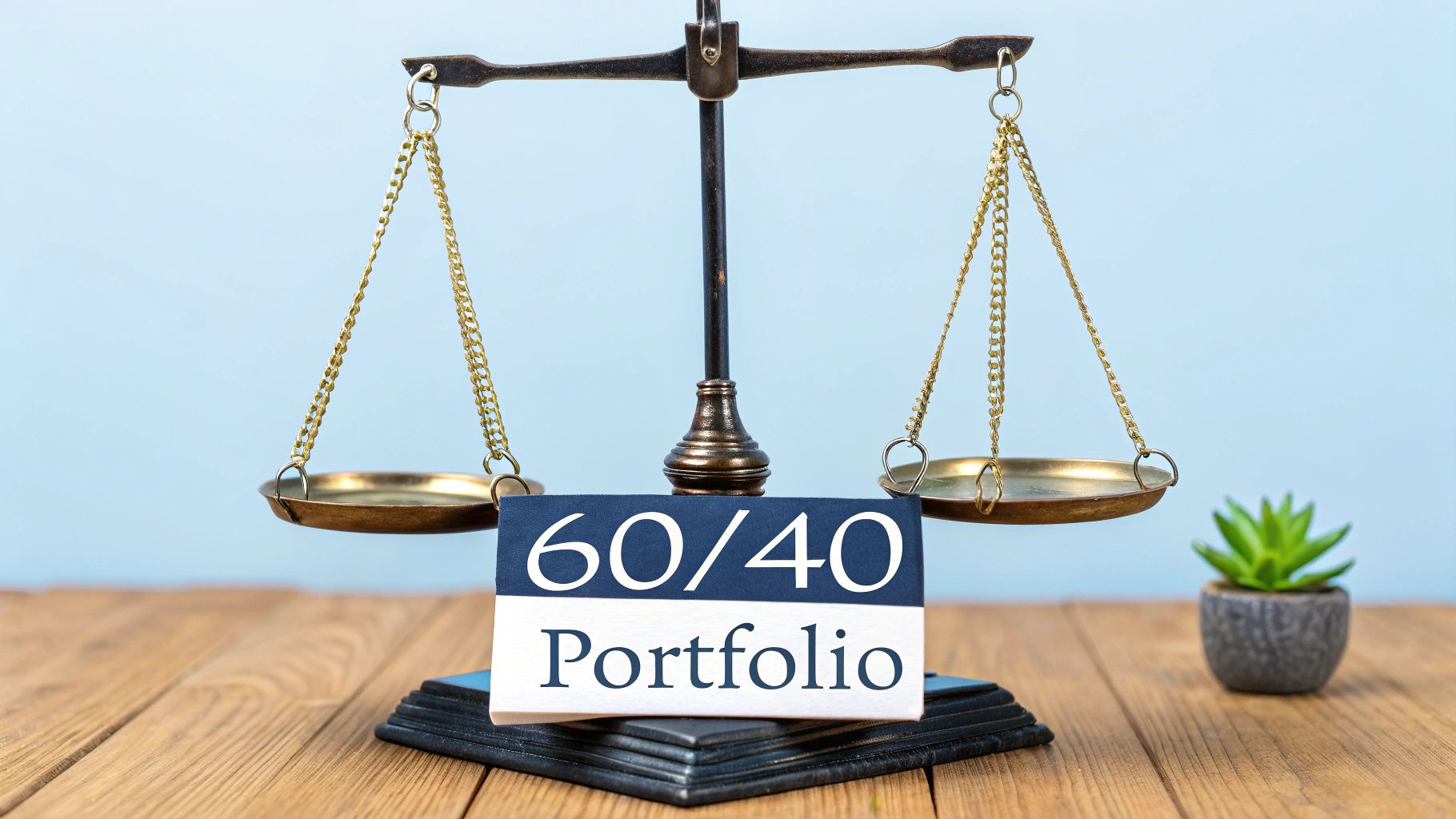Diversification: Your Key to Financial Success
Investment success isn't about chasing hot stock tips - it's about spreading your money across different types of investments in a smart way. This practice, called diversification, has roots going back centuries to merchants who distributed cargo across multiple ships to protect against losses. Think of it as following the age-old wisdom: "don't put all your eggs in one basket."
Diversification helps smooth out the ups and downs in your investment returns. When some investments aren't doing well, others can help pick up the slack. This approach reduces risk while still giving you opportunities for growth. It's so important that top investor Ray Dalio has called it the "holy grail" of investing.
Knowing how different investments work together - and how much money to put in each one - can make a huge difference in reaching your financial goals. In this guide, we'll look at 10 example investment portfolios built for different goals and comfort levels with risk. Whether you're building a business, planning for retirement, or working toward other financial targets, you'll find practical ways to structure your investments. Let's explore how to build a portfolio that fits your unique financial journey.
1. The Classic 60/40 Portfolio

The 60/40 portfolio represents one of the most time-tested investment approaches - putting 60% of your money in stocks and 40% in bonds. This straightforward strategy helps balance growth opportunities with stability, making it a go-to choice for many investors who want consistent returns without taking on too much risk.
The combination works because stocks and bonds often move differently. When stocks drop sharply, bonds typically hold steady or even gain value, helping protect your overall portfolio. The stock portion aims for higher long-term returns, while bonds provide steady income and act as a safety net during market downturns.
Key Features:
- Simple two-part mix: Easy to understand and manage, perfect for beginners
- Regular portfolio updates: Requires checking and rebalancing periodically
- Major market exposure: Covers the two biggest investment categories
- Long-term success: Has performed reliably over many decades
Advantages:
- Beginner-friendly: Simple concept that's easy to put into practice
- Natural protection: Bonds help smooth out stock market swings
- Lower risk: Less dramatic ups and downs than all-stock portfolios
- Proven results: Solid historical performance over time
Drawbacks:
- May not suit younger investors: Those with decades until retirement might want more stocks
- Limited asset types: Focuses only on stocks and bonds
- Bond challenges: Low interest rates can reduce bond returns
- Income considerations: May not generate enough cash flow for some retirees
Real-World Examples:
Implementation Tips:
- Check yearly: Review and rebalance your portfolio annually
- Keep costs low: Choose index funds with minimal fees
- Adjust for your situation: Consider your age and comfort with risk when setting your exact stock/bond mix
History and Relevance:
Investment legends like Jack Bogle helped popularize the 60/40 approach. Its track record spans multiple market cycles, proving its worth as a reliable strategy. For men aged 35-75 juggling career and family responsibilities while building wealth, this portfolio offers a practical foundation.
You can explore more investment strategies in our comprehensive guide at: https://thecoveredcallpod.com/post-sitemap1.xml. This resource provides additional perspectives on building your investment portfolio.
The 60/40 portfolio stands out for its simplicity, proven results, and balanced approach to risk and reward. It's particularly valuable for investors seeking a practical way to grow their wealth while maintaining financial security.
2. Three-Fund Portfolio
This simple but powerful investment approach uses just three total market index funds to build a globally-diversified portfolio. The three funds consist of a total US stock market fund, an international stock fund, and a bond fund. Let's look at how this straightforward strategy can help you build long-term wealth.
The three core funds that make up this portfolio are:
- Total US Stock Market Index Fund: Tracks broad US market indexes like the S&P 500, giving you exposure to the entire domestic stock market
- Total International Stock Market Index Fund: Provides diversified exposure to international stocks outside the US
- Total Bond Market Index Fund: Invests in a mix of US government and corporate bonds for stability and income
Key Benefits:
- Complete Market Coverage: Own virtually every publicly traded stock and bond globally
- Minimal Maintenance: Only needs rebalancing once per year
- Built-in Diversification: Thousands of holdings protect against single-stock risk
- Very Low Costs: Index funds keep expenses minimal
Advantages:
- Easy to Understand: Simple enough for beginners to implement
- Cost-Efficient: Rock-bottom expense ratios mean more money stays invested
- Broadly Diversified: Spreads risk across multiple asset classes
- Low Effort: Requires very little ongoing management
Potential Drawbacks:
- No Alternative Assets: Excludes real estate, commodities and private equity
- Limited Sector Focus: Can't target specific high-growth industries
- Broad vs Targeted: May miss out on concentrated market opportunities
Popular Fund Options:
- Vanguard Total Stock Market Index Fund (VTSAX): Low-cost US market exposure
- Vanguard Total International Stock Index Fund (VTIAX): Global stock diversification
- Vanguard Total Bond Market Index Fund (VBTLX): Broad bond market exposure
Implementation Tips:
- Choose Low-Cost Funds: Look for expense ratios under 0.2%
- Set Age-Based Mix: Consider 70% stocks/30% bonds for younger investors, more bonds as you age
- Rebalance Yearly: Reset allocations annually by selling winners and buying losers
History & Background:
This approach was popularized by Taylor Larimore and the Bogleheads community, who follow the low-cost indexing philosophy of Vanguard founder John C. Bogle. Its simplicity makes it ideal for busy professionals and entrepreneurs who want a solid investment foundation without complexity. You can focus your time and energy on growing your business while your portfolio grows steadily in the background.
3. All-Weather Portfolio

The All-Weather Portfolio is a smart investment approach created by Ray Dalio and his firm Bridgewater Associates. Instead of chasing big returns, this strategy focuses on protecting your money and delivering steady results no matter what's happening in the economy.
At its core is the concept of risk parity - balancing risk across different types of investments rather than just looking at potential returns. This is different from traditional portfolios that might put 60% in stocks and 40% in bonds. The All-Weather approach recognizes that different investments do well in different economic conditions.
Here's how the portfolio is typically split up:
- Stocks (30%): For long-term growth
- Intermediate-Term Bonds (40%): For stability and steady income
- Long-Term Bonds (15%): Protection during times of falling interest rates
- Gold (7.5%): Safety during uncertain times
- Commodities (7.5%): Protection against rising prices
Dalio built this portfolio after studying how markets behaved during different economic periods - inflation, deflation, growth, and recession. He found that certain investments consistently did better during specific conditions. This approach gained attention after 2008's financial crisis as investors looked for more reliable strategies.
Key Tips for Getting Started:
- Keep it simple by using ETFs or mutual funds to track each asset type
- Rebalance your portfolio every 3-12 months to maintain target percentages
- Be careful with borrowing money to invest - it's usually too risky for most people
- Talk to a financial advisor who understands this strategy before jumping in
Benefits:
- Performs steadily in different economic environments
- Strong focus on managing risk
- Less dramatic ups and downs than stock-heavy portfolios
- Smart diversification across different investment types
Drawbacks:
- Takes time to understand and set up properly
- Some versions use borrowed money, which can be dangerous
- May not keep up during strong stock market rallies
The All-Weather Portfolio stands out for its thoughtful approach to managing risk while aiming for consistent returns. While it requires more research and possibly professional help to implement, it offers a solid path toward financial stability. For long-term investors willing to prioritize steady growth over quick gains, this strategy provides a tried-and-tested framework.
4. Permanent Portfolio
Building wealth that lasts across all economic conditions - this was Harry Browne's vision when he created the Permanent Portfolio strategy. Rather than trying to predict market moves, this approach focuses on protecting your money through thoughtful diversification across assets that respond differently as economic conditions change.
The portfolio splits investments equally into four key areas:
- Stocks: For capturing growth during economic booms
- Long-Term Bonds: For income and stability, especially during economic slowdowns
- Gold: For protecting against inflation and economic uncertainty
- Cash: For stability and having funds readily available when needed
What Makes This Strategy Stand Out:
The beauty of the Permanent Portfolio lies in its straightforward nature and ability to handle different market conditions. By spreading investments across assets that don't move in lockstep, it aims to smooth out the investment journey. This makes it especially appealing for those who want financial security without constant portfolio adjustments.
History and Growing Interest:
Harry Browne first shared this strategy in his book "Fail-Safe Investing," arguing it could weather any economic environment. Its appeal comes from both solid historical results and clear, simple rules. While it may not match aggressive portfolios during bull markets, it aims to protect capital during downturns.
Real Results Through History:
Looking at past performance shows the portfolio's strength. During the difficult 1970s, when both stocks and bonds struggled with stagflation, the gold portion helped offset losses. In 2008's financial crisis, cash and gold helped cushion against falling stock prices. Though past results don't guarantee future success, these examples show how the strategy can work across different conditions.
Getting Started - Key Steps:
- Even Split: Put 25% of your money in each of the four investments
- Regular Rebalancing: Check and adjust back to 25% portions yearly - this naturally has you buying low and selling high
- Investment Options: Use ETFs or mutual funds for stocks/bonds, consider physical gold or gold ETFs, and keep cash in high-yield savings
- Stay Committed: Focus on long-term results rather than short-term market swings
Benefits:
- Strong Stability: Built to handle various economic conditions
- Well-Rounded Protection: Spreads risk across different types of investments
- Easy to Follow: Simple rules make it straightforward to manage
- Low Upkeep: Minimal ongoing adjustments needed
Drawbacks:
- Lower Returns in Strong Markets: May trail more aggressive strategies when stocks soar
- Gold's Impact: Large gold position may reduce overall returns
- Conservative Approach: May not suit investors seeking higher growth potential
For those seeking financial security without constant portfolio monitoring, the Permanent Portfolio offers a clear framework. Its focus on preservation and simple rules makes it well-suited for building lasting wealth while maintaining peace of mind.
5. Growth Stock Portfolio
A Growth Stock Portfolio aims to achieve above-average returns by investing in companies expected to grow rapidly. These companies typically operate in dynamic sectors like technology, healthcare, biotech, and renewable energy. While this approach can provide substantial gains, it carries more risk and volatility than traditional investment strategies. This makes it most suitable for investors with a long-term outlook and higher risk tolerance.
Features:
- High growth potential: Focuses on companies positioned for rapid expansion
- Emerging sector focus: Targets industries experiencing significant innovation and growth
- Higher volatility: Expect larger price swings due to the nature of growth companies
- Long-term horizon: Success requires patience as companies develop and mature
Pros:
- Higher return potential: Finding successful growth companies can create significant wealth
- Innovation exposure: Access to breakthrough technologies and market advances
- Technology gains: Benefit from technological progress and evolving consumer trends
Cons:
- Increased risk: The potential for high returns comes with greater possibility of losses
- Price swings: Growth stocks often experience significant market volatility
- Ongoing monitoring: Requires staying informed about market and company developments
- Premium pricing: Growth stocks typically trade at high valuations based on future expectations
Examples:
- ARK Innovation ETF (ARKK): An actively managed fund focused on disruptive innovation across sectors
- T. Rowe Price Growth Stock Fund (PRGFX): An established mutual fund with strong track record in growth investing
Key Figures:
Cathie Wood has brought attention to growth investing through her bold technology investments at ARK Invest. Peter Lynch helped popularize growth investing with his "invest in what you know" philosophy that resonated with individual investors.
Implementation Tips:
- Diversify holdings: Spread investments across different growth sectors and companies
- Research thoroughly: Understand business models, competition, and growth drivers
- Maintain long view: Stay focused on long-term potential despite short-term volatility
- Use dollar-cost averaging: Invest fixed amounts regularly to reduce timing risk
- Know your limits: Be realistic about your risk tolerance when allocating funds
Why Include Growth Stocks:
For entrepreneurs and professionals seeking substantial returns, growth stocks offer strong wealth-building potential. This approach fits those comfortable with calculated risks in pursuit of higher gains. While not ideal for conservative investors or those near retirement, growth stocks can be valuable in a diversified portfolio focused on long-term appreciation. They provide exposure to innovative companies shaping future industries and technologies.
6. Dividend Growth Portfolio
Investing in established companies that consistently grow their dividend payments over time creates a powerful path to financial independence. This approach gives investors both steady income and long-term growth potential, making it an excellent choice for building lasting wealth.
How it Works:
The strategy focuses on companies with strong market positions and solid financials that share profits through regular dividend payments. These are typically mature businesses with competitive advantages that help them maintain earnings growth even in tough times. As their profits increase, they raise dividend payments, creating a compounding effect on returns.
History and Growth:
This investment style gained prominence in the late 20th century, with pioneers like Geraldine Weiss showing its effectiveness for long-term success. It remains popular today, especially among retirees seeking reliable income without sacrificing growth. The rise of dividend-focused ETFs has made this strategy more accessible to everyday investors.
Key Benefits:
- Steady Income: Receive regular dividend payments for spending or reinvestment
- Quality Focus: Naturally directs investments toward financially strong companies
- Reduced Risk: Dividend payers tend to be more stable than high-growth stocks
- Compounding Power: Reinvesting dividends accelerates portfolio growth over time
Advantages:
- Predictable Income: Count on regular dividend payments throughout the year
- Lower Risk Profile: Established companies offer more stability
- Complete Returns: Get both dividend income and potential stock price gains
- Inflation Protection: Growing dividends help maintain purchasing power
Drawbacks:
- Growth Stock Lag: May underperform during strong bull markets
- Interest Rate Impact: Higher rates can make bonds more appealing
- Limited Universe: Excludes many growing tech companies and startups
Real-World Examples:
- Vanguard Dividend Appreciation ETF (VIG): Tracks companies with 10+ years of dividend growth
- ProShares S&P 500 Dividend Aristocrats ETF (NOBL): Focuses on 25+ year dividend growers
- Company Example: Johnson & Johnson (JNJ) has raised dividends for over 60 years, showing remarkable consistency through market cycles
Implementation Tips:
- Look for companies with at least 10 years of consistent dividend increases
- Check dividend sustainability - aim for payout ratios below 60%
- Spread investments across different sectors for better risk management
- Consider reinvesting dividends to maximize long-term returns
Building a portfolio of quality dividend growers can provide reliable income and wealth accumulation over time. This approach works especially well for investors seeking financial independence through steady passive income streams.
7. Factor Investing Portfolio

Factor investing is a data-driven approach that focuses on specific attributes like value, momentum, quality and size that research shows can lead to better returns over time. For entrepreneurs and investors looking to build wealth strategically, this evidence-based method offers an appealing alternative to basic index funds.
How Factor Investing Works
Rather than just buying the whole market, factor investing deliberately emphasizes companies with certain proven characteristics. Think of value stocks trading at bargain prices, momentum stocks with strong recent performance, quality companies with solid financials, or smaller companies that tend to outperform larger ones over time.
The Research Behind It
This approach emerged from groundbreaking work by economists Eugene Fama and Kenneth French in the 1990s. Their research revealed key drivers of stock returns that went beyond just market exposure. What started with institutional investors has now become accessible to individual investors through specialized ETFs and mutual funds.
Key Benefits
- Research-backed: Built on decades of academic studies and real-world data
- Systematic process: Uses clear rules rather than emotions to guide decisions
- Multi-factor exposure: Spreads risk across different return drivers
- Transparent methodology: Makes portfolio changes predictable
- Higher return potential: Aims to beat market averages over time
- Better diversification: Goes beyond basic market-cap weighting
What to Consider
Advantages:
- Built on extensive research
- Clear, systematic approach
- Strong diversification benefits
- Potential for better returns
Drawbacks:
- More complex than basic indexing
- Requires patience during underperformance
- Often has higher costs than simple index funds
Real Examples
Dimensional Fund Advisors pioneered factor investing for retail investors. iShares also offers factor ETFs that make this approach more accessible. Looking at their long-term results shows how factor investing works in practice.
Getting Started Tips
- Learn the basics of different factors and how they perform
- Know your risk tolerance - factors can underperform at times
- Pick appropriate investment vehicles like ETFs
- Use multiple factors for diversification
- Stay focused on long-term results
For investors willing to look beyond basic indexing and stick with a proven long-term approach, factor investing offers a compelling path to potentially higher returns. While it requires more understanding than simple buy-and-hold strategies, the academic foundation and systematic process make it worth considering for serious wealth-builders.
8. Target Date Portfolio
Target Date Portfolios (TDFs) offer a straightforward and low-maintenance approach to retirement investing. By automatically adjusting asset allocation over time, TDFs provide a "set-and-forget" option that becomes more conservative as you get closer to retirement age.
How TDFs Work:
These funds invest in a mix of assets, mainly stocks and bonds, with some real estate and commodities. When retirement is far away, the portfolio focuses heavily on stocks for growth potential. As your target date approaches, it shifts more into bonds to protect your savings. This built-in rebalancing removes the need to constantly monitor your investments.
Key Benefits:
TDFs shine in their ability to simplify retirement planning. For busy professionals and anyone who finds investment management overwhelming, these funds handle the complex work automatically. You can focus on your career and life goals while your retirement savings adjust appropriately over time.
Main Features:
- Smart Rebalancing: Portfolio mix changes automatically based on your timeline
- Age-Based Strategy: Investment approach matches your life stage
- Expert Management: Investment professionals handle ongoing adjustments
- Low Maintenance: Minimal time needed for oversight
Real Examples:
Two popular choices are Vanguard Target Retirement Funds and Fidelity Freedom Funds. Both offer funds aligned to different retirement years. Studies have shown TDFs can deliver solid long-term results while helping investors stick to their plans.
Growing Popularity:
TDFs took off in the late 1990s as retirement planning shifted toward 401(k)s and similar accounts. More workers needed simple, managed investment options. The funds filled this need by handling asset allocation automatically.
Advantages:
- Hands-off approach: Minimal time investment needed
- Professional oversight: Expert portfolio management
- Age-appropriate risk: Risk levels adjust over time
- Auto-rebalancing: No manual changes required
Disadvantages:
- Higher costs: Management fees exceed DIY investing
- Generic approach: May not fit individual needs
- Limited control: Less ability to customize holdings
- Conservative bias: May limit returns for some investors
Implementation Tips:
- Select the fund matching your expected retirement year
- Review the specific investments in the fund
- Compare fees between different providers
Understanding these key aspects helps determine if a Target Date Portfolio aligns with your retirement goals and investing style. The automatic adjustments and professional management can provide peace of mind, though the approach may not suit everyone's specific situation.
9. Income-Focused Portfolio
An income-focused portfolio aims to provide regular income rather than aggressive growth. It's particularly suited for retirees or those wanting steady cash flow from their investments. These portfolios typically include bonds, dividend stocks, Real Estate Investment Trusts (REITs), and preferred stocks.
Features:
- High yield focus: Maximizes ongoing income generation
- Multiple income sources: Spreads risk across different income-producing assets
- Regular cash flow: Delivers predictable monthly or quarterly payments
- Capital preservation: Protects the initial investment while generating income
Pros:
- Steady income: Provides reliable payments, ideal for retirees
- Lower risk: Shows less price volatility than growth portfolios
- Retirement-friendly: Helps cover living expenses in retirement years
- Diversified income: Reduces reliance on any single investment source
Cons:
- Rate sensitivity: Bond values typically fall when interest rates rise
- Growth limitations: Focus on income may reduce capital appreciation
- Inflation risk: Fixed payments may lose purchasing power over time
Understanding and Application:
This approach became essential as traditional pensions declined and lifespans increased. Many investors now need to create their own retirement income streams, making income-focused portfolios an important tool for financial security.
Real-world examples:
A typical case might be a retiree using dividend stocks and corporate bonds for monthly income. Another example is an investor owning REITs that generate rental income. Research confirms that well-diversified income portfolios can provide stable retirement funding.
Practical Tips:
- Mix income sources: Combine dividend stocks, bonds, REITs, and preferred shares
- Consider taxes: Use tax-advantaged accounts and municipal bonds where appropriate
- Watch interest rates: Monitor rate changes and adjust bond holdings as needed
Why This Strategy Matters:
Income-focused portfolios offer a solid alternative to growth investing. The emphasis on steady income and principal protection makes this approach valuable for those seeking financial security and regular cash flow. It's especially relevant for retirees and anyone wanting dependable investment income without taking on excessive risk.
10. Socially Responsible Portfolio

For investors who want their investments to make a positive difference while earning returns, a Socially Responsible Portfolio can be an excellent choice. This approach focuses on companies that meet Environmental, Social, and Governance (ESG) standards, letting you invest according to your values. As more people seek to invest ethically, this strategy has become increasingly popular.
The core of ESG investing goes beyond just avoiding controversial industries. It actively seeks out companies making positive contributions through their environmental practices, treatment of workers, and corporate leadership. Impact investing, which aims for measurable social benefits alongside financial returns, is a key part of this approach. This lets you support solutions to global challenges while building your wealth.
ESG investing has become much more accessible through mainstream investment products. Major providers like Vanguard and iShares offer ESG-focused ETFs that make it simple to build a diversified responsible portfolio. The growing number of options means you don't have to sacrifice diversification for values.
This investing style gained credibility when well-known investors proved it could deliver solid returns. Research increasingly shows that companies with strong ESG practices can perform as well as or better than others, partly by reducing risks related to environmental and social issues.
Practical Tips for Implementation:
- Define your values: Choose which social and environmental priorities matter most to guide your choices
- Research ESG funds: Compare expense ratios and holdings of major ESG ETFs
- Consider expert help: An advisor with ESG expertise can help build a portfolio matching your values
- Start gradually: Begin with a portion in ESG investments while maintaining diversification
- Monitor developments: Stay current on ESG trends to make informed decisions
Pros:
- Values alignment: Support companies that reflect your principles
- Competitive performance: Research shows ESG investing can deliver strong returns
- Lower ESG risk: Reduce exposure to environmental and social controversies
- Many options: Wide selection of ESG funds available
Cons:
- Narrower choices: ESG criteria limit the pool of potential investments
- Cost factors: Some ESG funds charge higher fees than standard options
- Rating variations: ESG scoring methods differ between providers
- Ongoing debate: Discussion continues about long-term ESG performance
This approach works especially well for investors who want their money to create positive change. For entrepreneurs and those building long-term wealth, socially responsible investing offers a path to financial success while supporting a better future.
Side-by-Side Comparison of 10 Investment Portfolios
| Portfolio Title | 🔄 Complexity | ⚡ Resources | 📊 Outcomes | ⭐ Advantages |
|---|---|---|---|---|
| The Classic 60/40 Portfolio | Simple two-asset; regular rebalancing needed | Low – uses common index funds | Balanced growth and stability with proven track record | Diversification; easy to understand and implement |
| Three-Fund Portfolio | Very low; straightforward allocation | Minimal – low-cost ETFs/mutual funds | Broad market exposure with high diversification | Maximum simplicity; very low costs |
| All-Weather Portfolio | High – complex risk parity and multi-assets | Advanced – requires sophisticated management | Performs in various economic conditions | Strong risk management; diversified across asset classes |
| Permanent Portfolio | Moderate – equal allocation across four assets | Low – simple, balanced rebalancing | Stability across different economic environments | High stability; preservation focus |
| Growth Stock Portfolio | Moderate to high – active management required | Higher – demands market research and analysis | Potential for high returns driven by innovation | Exposure to emerging trends; benefit from technological gains |
| Dividend Growth Portfolio | Moderate – requires monitoring dividend trends | Moderate – depends on consistent dividend payers | Regular income stream with potential for compound growth | Lower volatility; natural inflation hedge |
| Factor Investing Portfolio | High – rules-based multi-factor strategy | Moderate to high – based on research-driven funds | Potential for outperformance via systematic factor exposure | Evidence-based; diversified with academic insights |
| Target Date Portfolio | Low – set-and-forget with automatic rebalancing | Moderate – professional management fees | Age-adjusted risk leading to smoother retirement transitions | Simplified approach; automatic rebalancing |
| Income-Focused Portfolio | Moderate – emphasis on income sources | Moderate – multiple income vehicles | Generates regular cash flow with lower volatility | Multi-source income; suited for retirees |
| Socially Responsible Portfolio | Moderate – ESG integration can add layers | Moderate – may incur higher fees and limits | Balances competitive returns while aligning with personal values | Values-based investing; growing universe of options |
Building Your Ideal Investment Portfolio
Smart investment strategies can take many forms. The classic 60/40 portfolio, dividend-focused approach, and socially responsible investing each offer unique paths to building wealth. What matters most is finding an approach that matches your personal situation and goals.
Start by understanding your own financial picture. Ask yourself: What am I investing for - retirement, a home purchase, or creating generational wealth? How do I react to market swings? What timeline do I have to achieve my goals? Your answers will point you toward the right investment mix. Remember that spreading investments across different types of assets and checking your portfolio balance regularly are key practices for managing risk while pursuing strong returns.
The investment world keeps evolving. New approaches like factor investing and ESG (Environmental, Social, and Governance) screening are gaining traction. To succeed long-term, keep learning about emerging strategies while regularly reviewing how your investments are performing. Making thoughtful adjustments helps you stay on course toward your financial targets. Getting input from a qualified financial advisor can provide valuable perspective as you navigate investment decisions.
Key Steps for Success:
- Match your investment approach to your goals, risk comfort level, and timeline
- Spread investments across multiple types of assets
- Check and rebalance your portfolio on a set schedule
- Stay current on market developments and adapt when needed
- Consider working with a professional advisor for guidance
Ready to take control of your financial future? The Covered Call Podcast shares inspiring stories and practical strategies for building wealth and financial independence. Join hosts Jason Nutter and Lovis Kauf as they interview successful investors like Luke Gromen, Rick Rule, Doug Casey, Peter Alexander and Adrian Day. Learn how they transitioned from traditional careers to lives of purpose and prosperity. Discover proven approaches to grow your wealth and live life on your terms. Start listening to The Covered Call Podcast today: The Covered Call Podcast

